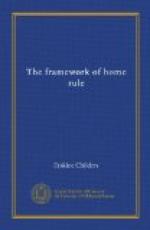Statesmen who looked with complacency on the history of a century in Ireland under such a system naturally took a similar view of the Transvaal, deriving it from the same low estimate of human tendencies. The literature, despatches, and speeches of the period carry us straight back to the Canadian controversies of 1837-1840, and beyond them to the Union controversy of 1800. In one respect the parallel with the Irish Union is closer, because, while British opinion in Lower Canada was predominantly against responsible government, there was in Ireland a strong current of unbribed Protestant opinion against the Union. Similarly, in the Transvaal, there was a strong feeling among a section of the British population, coinciding with the general wishes of the Dutch population, in favour of full responsible government. In other words, the mere prospect of self-government lessened racial cleavage, brought men of the two races together, and began the evolution of a new party cleavage on the normal lines natural to modern communities. The whole question was keenly canvassed at public meetings and in the Press from November, 1904, to February 5, 1905, and in Johannesburg a British party of considerable strength took the lead in demanding the fuller political rights, and formed the Responsible Government Association. The controversy was embodied in a Blue-Book laid before Parliament,[35] and at every stage of its progress the facts were cabled home by Lord Milner to the Government, who thus had the whole situation before them when they came to their decision.




